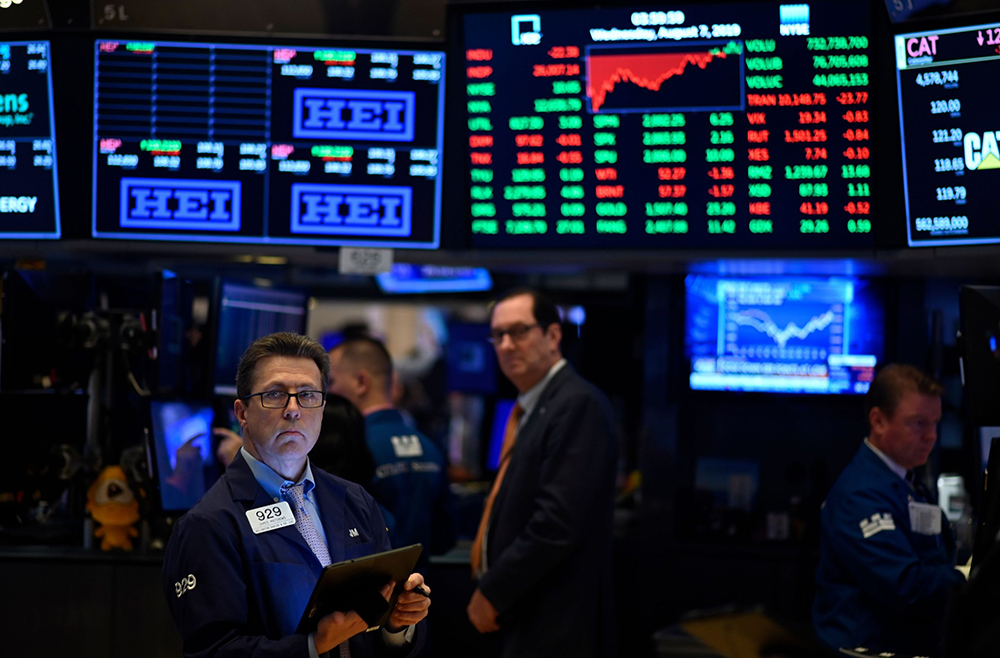美国国债收益率暴涨,再次拉响衰退警报

投资者们有合理的理由对美国经济尚未出问题感到惊讶:上一次美国政府债券收益率大幅快速上涨,使美国陷入了连续的经济衰退。
过去三年,10年期国债收益率上涨了超过整整四个百分点,本周一度突破了5%,这是自2007年以来的首次。10年期国债收益率是金融系统衡量资金成本的关键基准指标。上世纪80年代初,10年期国债收益率大幅上涨,当时保罗·沃克为应对通胀所做的努力,使10年期国债收益率暴涨至近16%。现在,10年期国债收益率创下在那之后的最大涨幅。
在某种意义上,这种相似性并不意外,因为美联储主席杰罗姆·鲍威尔采取了自那之后最激进的加息。另一方面,它也强调了时代已经不同。
上世纪80年代,激进的货币政策引发了两次经济衰退。现在经济的表现依旧超出了许多人的悲观预测,亚特兰大联储(Atlanta Fed)的估计显示,第三季度,美国经济将更加强劲。
当然,在沃克主持美联储期间,采取了更紧缩的货币政策。彭博社汇总的数据显示,从1981年年中开始,到美国陷入第二次经济衰退的时候,针对消费物价上涨调整后的“实际”10年期国债收益率(扣除通胀后的收益率)约为4%。现在约为1%。
但经济出人意料地强劲增长,却加剧了市场的不确定性。过去几个月债券收益率大幅上涨,而且有越来越多人相信美联储会继续维持高利率。
这种经济韧性能否持久,仍有待观察。亿万富翁投资者比尔·阿克曼周一平掉了做空长期债券的空仓,他表示美国经济正在快速放缓。
但在年初也有类似的观点,还有人预测随着美联储改变立场,债券市场将会反弹。
而实际上,债券价格却持续下跌。彭博美国国债总体指数(Bloomberg US Treasury Total Index)今年下跌约2.6%,跌幅已从2020年8月的最高点扩大至18%。相比之下,之前从最高点到最低点的最大跌幅是1980年的约7%。当时美联储的关键基准利率达到了20%。当前的跌幅之所以比以往更加严重,是因为利率一直较低,导致投资者没有足够的利息收入帮助抵消下跌带来的影响。
另外一个因素是,联邦赤字大幅增加。当传统的主要买家,包括美联储和其他主要央行,均减少购买债券时,美国向市场发行了大量新国债。这被认为是最近几周,当期货市场表明交易商预期美联储可能已经停止加息时,国债收益率上涨的原因之一。
摩根大通资产管理公司(JPMorgan Asset Management)的投资组合经理普利亚·米斯拉表示:“我们的基准情景是硬着陆,但我无法拿出任何数据说:‘这是明显的经济衰退的先导指标,要注意这个指标。’”
她说道:“投资者的信心水平较低。”她还表示,购买债券的投资者”都受到了伤害“。(财富中文网)
译者:刘进龙
审校:汪皓
投资者们有合理的理由对美国经济尚未出问题感到惊讶:上一次美国政府债券收益率大幅快速上涨,使美国陷入了连续的经济衰退。
过去三年,10年期国债收益率上涨了超过整整四个百分点,本周一度突破了5%,这是自2007年以来的首次。10年期国债收益率是金融系统衡量资金成本的关键基准指标。上世纪80年代初,10年期国债收益率大幅上涨,当时保罗·沃克为应对通胀所做的努力,使10年期国债收益率暴涨至近16%。现在,10年期国债收益率创下在那之后的最大涨幅。
在某种意义上,这种相似性并不意外,因为美联储主席杰罗姆·鲍威尔采取了自那之后最激进的加息。另一方面,它也强调了时代已经不同。
上世纪80年代,激进的货币政策引发了两次经济衰退。现在经济的表现依旧超出了许多人的悲观预测,亚特兰大联储(Atlanta Fed)的估计显示,第三季度,美国经济将更加强劲。
当然,在沃克主持美联储期间,采取了更紧缩的货币政策。彭博社汇总的数据显示,从1981年年中开始,到美国陷入第二次经济衰退的时候,针对消费物价上涨调整后的“实际”10年期国债收益率(扣除通胀后的收益率)约为4%。现在约为1%。
但经济出人意料地强劲增长,却加剧了市场的不确定性。过去几个月债券收益率大幅上涨,而且有越来越多人相信美联储会继续维持高利率。
这种经济韧性能否持久,仍有待观察。亿万富翁投资者比尔·阿克曼周一平掉了做空长期债券的空仓,他表示美国经济正在快速放缓。
但在年初也有类似的观点,还有人预测随着美联储改变立场,债券市场将会反弹。
而实际上,债券价格却持续下跌。彭博美国国债总体指数(Bloomberg US Treasury Total Index)今年下跌约2.6%,跌幅已从2020年8月的最高点扩大至18%。相比之下,之前从最高点到最低点的最大跌幅是1980年的约7%。当时美联储的关键基准利率达到了20%。当前的跌幅之所以比以往更加严重,是因为利率一直较低,导致投资者没有足够的利息收入帮助抵消下跌带来的影响。
另外一个因素是,联邦赤字大幅增加。当传统的主要买家,包括美联储和其他主要央行,均减少购买债券时,美国向市场发行了大量新国债。这被认为是最近几周,当期货市场表明交易商预期美联储可能已经停止加息时,国债收益率上涨的原因之一。
摩根大通资产管理公司(JPMorgan Asset Management)的投资组合经理普利亚·米斯拉表示:“我们的基准情景是硬着陆,但我无法拿出任何数据说:‘这是明显的经济衰退的先导指标,要注意这个指标。’”
她说道:“投资者的信心水平较低。”她还表示,购买债券的投资者”都受到了伤害“。(财富中文网)
译者:刘进龙
审校:汪皓
There’s a good reason why investors are amazed that something hasn’t broken in the economy yet: The last time US government bond yields climbed so far, so fast, the nation plunged into back-to-back recessions.
The 10-year Treasury yield — a key baseline for the cost of money across the financial system — has jumped more than four full percentage points over the past three years, briefly pushing it this week over 5% for the first time since 2007. It’s the biggest increase since the run up in the early 1980s, when Paul Volcker’s efforts to slay inflation pushed the 10-year yield to nearly 16%.
In one sense, the similarities are no surprise, since Fed Chair Jerome Powell’s interest-rate hikes have been the most aggressive since then. In another, it underscores just how much times have changed.
In the 1980s, the monetary policy onslaught set off two recessions. Now, the economy has continued to defy pessimistic forecasts, with the Atlanta Fed’s estimate showing that in the third quarter it likely even gained steam.
Of course, policy was more restrictive during the Volcker era. Adjusted for consumer-price increases, the “real” 10-year Treasury yield — or what it paid after inflation — was around 4% by the time the second downturn of the period started in mid-1981, according to data compiled by Bloomberg. It’s around 1% now.
But the surprising economic strength has nevertheless injected large amounts of uncertainty into markets, where bond yields have pushed up sharply over the past several months amid increasing conviction that the Fed will keep interest rates high.
Whether such resilience can be sustained remains to be seen. Billionaire investor Bill Ackman closed his bearish bets against long-term bonds Monday, saying the economy is slowing fast.
Yet the year began with similar calls, accompanied by expectations that the bond market would rally as the Fed changed course.
Instead, bond prices have kept tumbling. The Bloomberg US Treasury Total Index is down about 2.6% this year, extending its losses since the peak in August 2020 to 18%. In comparison, the worst peak-to-trough drawdown previously was a decline of about 7% in 1980, when the Fed’s key benchmark hit 20%. This selloff has been more painful because rates had been low, depressing the income payments that help to offset the hit.
Another factor has been the sharp increase in the federal deficit, which is flooding the market with new Treasuries at a time when traditional big buyers, including the Fed and other major central banks, have pulled back on bond buying. That’s seen as one reason why yields have marched higher in recent weeks even as the futures market shows traders think the Fed’s rate hikes are likely done.
“A hard landing is sort of our base case scenario — but I can’t point to any data and say, ‘This is a clear leading indicator of a recession and look right here,’”said Priya Misra, a portfolio manager at JPMorgan Asset Management
“Conviction levels are low,” she said. Investors who had been buying bonds “have all been hurt,” she said.













